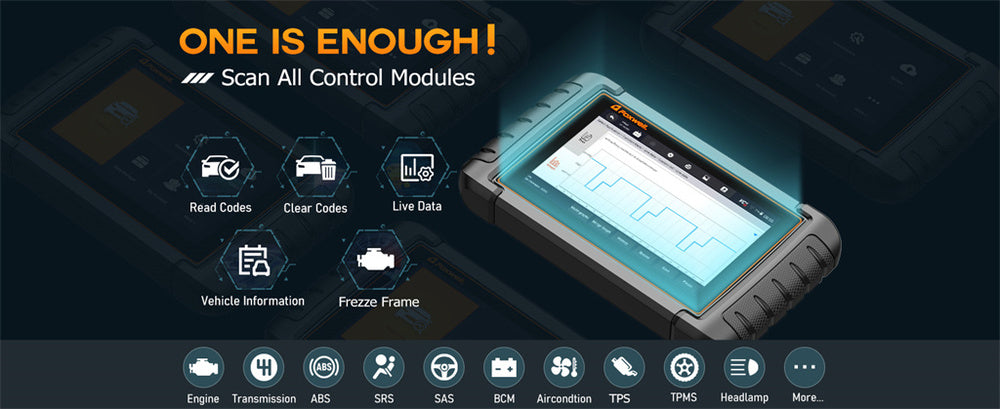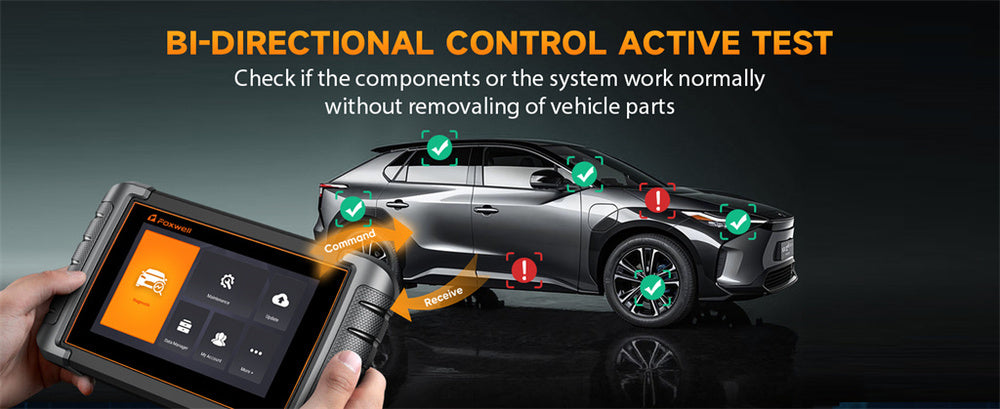Diesel vehicles come with Diesel Particulate Filters (DPFs) to help cut down harmful emissions. Over time, these filters can get clogged with soot and other particles, making DPF regeneration essential. We’ll explore how car scanners help with DPF regeneration, why this process is crucial, and how you can use these tools to keep your vehicle running smoothly.
Introduction to DPF Regeneration

DPF regeneration is a must for diesel engines. The DPF traps soot from the exhaust to keep it from polluting the air. However, when the filter gets too full, it can cause engine problems and more emissions. Regeneration burns off the accumulated soot, so the DPF can keep doing its job.
There are three main types of DPF regeneration:
Passive Regeneration: Happens naturally when the exhaust temperature is high.
Active Regeneration: Kicks in when the vehicle’s engine control unit (ECU) senses it's needed.
Forced Regeneration: Done using diagnostic tools when passive and active regeneration aren’t enough.
The Role of Car Scanners in DPF Regeneration
Car scanners are fantastic tools for managing DPF regeneration. These devices connect to your vehicle’s onboard diagnostic (OBD) system, giving you real-time data and diagnostic info. Here’s how they help:
- Monitoring Soot Levels: Car scanners can show you how much soot has built up in the DPF, so you know when regeneration is needed. By continuously monitoring soot levels, you can avoid the risk of DPF clogging, which can lead to reduced engine performance and increased emissions.
- Real-Time Alerts: Advanced scanners provide real-time alerts when soot levels reach a critical point, prompting immediate action to prevent damage.
- Detailed Reports: Some scanners generate detailed reports on soot accumulation, helping you understand the regeneration cycle better and plan maintenance more effectively.
- Initiating Forced Regeneration: If the DPF is really clogged, a car scanner can start a forced regeneration to burn off the soot. This process involves the scanner sending a command to the vehicle's ECU to initiate a high-temperature burn-off of the soot deposits.
- User-Guided Process: Many scanners come with step-by-step instructions, making it easy even for beginners to perform forced regenerations safely.
- Safety Precautions: The scanner ensures that all safety conditions are met before starting the process, such as proper engine temperature and safe location, to prevent any accidental damage.
- Checking Regeneration History: These tools can display past regeneration cycles, helping you track your DPF’s health. By keeping a log of previous regenerations, you can identify patterns and address recurring issues proactively.
- Trend Analysis: Analyze the frequency and effectiveness of past regenerations to adjust driving habits or maintenance schedules for optimal DPF performance.
- Maintenance Scheduling: Use historical data to predict when the next regeneration might be needed and plan accordingly.
- Diagnosing Issues: Car scanners can find problems related to the DPF and exhaust system, giving you error codes and troubleshooting tips. This functionality helps you pinpoint the exact issue, whether it's a sensor malfunction or an actual DPF problem.
- Error Code Interpretation: Scanners often provide explanations for error codes, making it easier to understand what needs to be fixed.
- Comprehensive Diagnostics: Besides DPF issues, these scanners can diagnose other engine and system problems, giving you a complete health check of your vehicle.
Benefits of Using Car Scanners for DPF Regeneration
Using car scanners for DPF regeneration offers several significant benefits:
- Save Money: Regular monitoring and timely regeneration can prevent costly repairs and replacements. By catching issues early, you avoid major expenses down the line.
- Boost Performance: A clean DPF ensures that your engine runs smoothly and improves fuel efficiency. This helps maintain your vehicle’s overall performance.
- Stay Eco-Friendly: Proper DPF maintenance reduces harmful emissions, keeping your vehicle compliant with environmental laws. This contributes to cleaner air and a healthier environment.
- Convenience: Car scanners allow you to handle DPF regeneration at home, saving you time and money on trips to the mechanic. Their user-friendly interfaces make them accessible even to those with little technical knowledge.
How to Use a Car Scanner Efficiently and Frequently
To get the most out of your car scanner for DPF regeneration, follow these tips:
- Regular Monitoring: Check soot levels frequently to know when regeneration is needed. Consistent monitoring helps you stay ahead of potential problems and ensures that your DPF is always in good condition.
- Weekly Checks: Make it a habit to check soot levels at least once a week, especially if you do a lot of city driving, which can cause faster soot accumulation.
- After Long Trips: After long highway drives, check the soot levels to see if passive regeneration has occurred, reducing the need for active or forced regeneration.
- Scheduled Checks: Set reminders to check the DPF status regularly, like every month or after a certain number of miles. Regular checks help you maintain a routine and ensure that you don't miss any necessary maintenance.
- Mileage-Based Reminders: Set your scanner to remind you after every 500 miles to check the DPF status.
- Monthly Maintenance: Incorporate DPF checks into your monthly vehicle maintenance schedule to keep your vehicle in top shape.
- Prompt Regeneration: Start forced regeneration as soon as the scanner shows high soot levels to avoid engine problems. Timely action can prevent more serious issues and keep your vehicle running efficiently.
- Immediate Response: Don’t wait for the soot levels to get too high; initiate regeneration as soon as you get a warning from your scanner.
- Preventive Maintenance: Regularly perform forced regeneration as a preventive measure, even if the soot levels are not critically high, to keep the DPF clean.
- Maintenance Logs: Keep records of each regeneration cycle, including dates and soot levels, to track your DPF's health. Detailed logs help you understand the performance of your DPF over time and make informed maintenance decisions.
- Digital Records: Use your scanner’s logging feature to maintain digital records, making it easy to track and review the history.
- Manual Logs: Keep a notebook in your glove compartment to jot down details of each regeneration cycle for quick reference.
- Consistent Diagnostic Scans: Regularly use the scanner to run full diagnostic checks, ensuring any potential issues are caught early. Comprehensive diagnostics can prevent unexpected breakdowns and costly repairs.
- Monthly Scans: Perform a full diagnostic scan once a month to catch any issues early and keep your vehicle in top condition.
- Pre-Trip Checks: Before long trips, run a full diagnostic scan to ensure your vehicle is road-ready and to avoid any issues on the road.
Combining Car Scanner Functions for Vehicle Diagnostics and Maintenance
Car scanners aren’t just for DPF regeneration. They can work with other functions to help you maintain and diagnose your vehicle:
- Engine Diagnostics: Find and fix engine problems to keep your car running smoothly. Scanners can read engine error codes and provide solutions to common problems.
- Transmission Health: Check for transmission issues before they become major problems. Regularly scanning for transmission faults can help maintain smooth gear shifts and extend the life of your transmission.
- ABS and SRS Systems: Ensure the Anti-lock Braking System (ABS) and Supplemental Restraint System (SRS) are working correctly. These safety systems are crucial for vehicle safety and performance.
- Battery and Charging Systems: Monitor the health of your battery and charging system to avoid unexpected breakdowns. Scanners can check battery voltage and charging efficiency, helping you avoid battery failures.
- Emissions Testing: Make sure your vehicle meets emissions standards by checking exhaust gases and related systems. Regular emissions tests can ensure your vehicle stays compliant with environmental regulations.
- Service Reminders: Reset service indicators and keep track of regular maintenance schedules. Scanners can remind you of upcoming service needs, helping you maintain a consistent maintenance routine.

Conclusion
DPF regeneration is crucial for keeping your diesel vehicle in top shape and reducing emissions. Car scanners make it easy and efficient to manage this process, ensuring your vehicle runs smoothly and stays environmentally friendly. By learning how to use these tools, you can save money, improve performance, and help keep the air cleaner.
Investing in a good car scanner is a smart choice for any diesel vehicle owner. It gives you control over DPF maintenance, helps prevent issues, and extends your engine’s life. Stay proactive with your vehicle’s health, and enjoy a smoother, more efficient driving experience.
FAQs
What is DPF regeneration in a car?
DPF regeneration burns off soot accumulated in the diesel particulate filter, maintaining its effectiveness.
How does a car scanner assist with DPF regeneration?
It monitors the DPF status, initiates regeneration, and detects issues to ensure optimal filter performance.
Why is regular DPF regeneration necessary?
It prevents filter clogging, maintains engine efficiency, and reduces harmful emissions from diesel vehicles.




Leave a comment
This site is protected by hCaptcha and the hCaptcha Privacy Policy and Terms of Service apply.